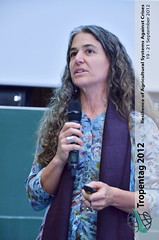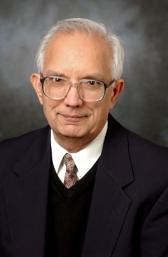soils
CIAT celebrates its 45 years anniversary
Sat, 09/22/2012 - 14:30 — De-Registered User
Tropentag 2012 hosts an oral session dedicated to the International Center for Tropical Agriculture (CIAT).
The title of the session from CIAT is “soil and resilience".In the session, five scientists from CIAT presents various aspects of research on soils and resilience.
For the one that did not attain the session, the following video is an exclusive interview of Dr. Bossio. For you, she highlights the main message the session tries to convey.
To read more on the content of the presentations, click on one of the following title:
Domestication of soil variability in Sub-Saharan Africa: Almost there (Job Kihara's presentation)
Quesungual Slash and Mulch Agroforestry System (QSMAS): provider of ecological services (Aracely Castro's presentation)
Prevent irreversible degradation of agro-ecoystem in Amazonia now! (Patrick Laville's presentation
This year Mrs. Bossio is one of the key note speakers. She conveys an interesting message on soil management practice. For more details and a second interview of her, click on the following link: Soil is back on the agenda.
Domestication of soil variability in Sub-Saharan Africa: Almost there
Sat, 09/22/2012 - 14:20 — De-Registered User
Job Kihara presents a research, which tries to understand variability in crop response to fertilizer and amendments in Sub-Saharan Africa (SSA).
The objectives of the study are to identify i) soil fertility constraints to crop production, ii) the occurrence of responsive and non-responsive fields, iii) key response patterns, and iv) to identify existing links between crop response to nutrient application and soil spectra.
The research set up allows scientists to collect data on more than 400 African farms. The researchers analyse crop responses on eight fertilizer treatments.
In most sites, results show that the nutrient limitations are in order N>P>K. In acidic soils, K is as limiting as N and P. Results demonstrate a wide existence of non-responsive soils to NPK treatments compared to soil amendments consisting of lime, manure, and multi-nutrients.
In his presentation, Job Kihara only shows a tiny part of the research he is involved in. They create an amazing website containing many information on African soils explored with interactive maps. For further informations, have a look at the website of the African Soil Information Service.
The Quesungual Slash and Mulch Agroforestry System (QSMAS): provider of ecological services
Sat, 09/22/2012 - 14:08 — De-Registered User
The QSMAS presents a sustainable alternative to the traditional practices of central America. Aracely Castro explains that QSMAS can provide Ecosystem Services (ES). Benefits that people get from the nature is the definition of ES.
In the sub-humid tropics of central America, traditional agroforestry systems imply slash and burn of plots, followed by 1 to 3 years of cropping. Then, the land needs at least 7 years to regenerate (fallow). In contrast, the QSMAS cycle is made of slash and mulch during nearly 12 years of cropping. Then, the land needs also 7 years to regenerate.
This smallholders production system combines basic management principles to improve the use and conservation of vegetation, soil, and water (increase infiltration and decreased runoff). It improves resilience, productivity, and sustainability. It reduces shifting cultivation in drought-prone hillsides of the sub-humid tropics. Last but not least, it acts favourably on the global warming potential (GWP) through improved C accumulation and low methane emission.
Prevent irreversible degradation of agro-ecoystem in Amazonia now!
Sat, 09/22/2012 - 13:48 — De-Registered User
In this breaking through research, Patrick Lavelle from the International Center for Tropical Agriculture (CIAT) together with a transdisciplinary team figure out the tipping point between landscape intensification and ecoefficiency in the Amazonia .
First, the team determines a measure scale to landscape intensification in Amazonia. Degraded pastures are on the extensive extremity of the scale and tropical forest on the intensive extremity. The following indicators measures the change in socio-environmental components and landscape use intensification: i) human development, ii) economical efficiency, iii) biodiversity, and iv) ecosystem services. The sum all four indicators indicates the prevailing ecoefficiency.
Two regions composed of six landscape windows, 54 farms and 270 sampling points enables the collection of the data. To study the relationship between ecoefficiency and landscape intensification in Amazonia, the data is plotted together.
The resulting curve draw a tipping point. This point represents the optimal ecoefficiency and landscape intensification level. In Amazonia, ecoefficiency is optimal when there is a 50 % level of forest (20% pristine and 30% fallows/tree based systems).
According to Dr. Lavelle, to reach a woody cover of 50 %, the actual mainstream agricultural practice need to be stopped in Amazonia.
------------------------------------------------------------------------
Soil is back on the agenda
Wed, 09/19/2012 - 19:50 — De-Registered User
In this period of rapid change in land use, hunger is still a problem. In order to fight hunger, the promotion of ecological resiliency is needed.
This is the main message Dr. Deborah Bossio, holding a PhD in Soil Science from the University of California, USA and working at the International Center for International Agriculture (CIAT), conveyed in today's second plenary speech.
 Dr. Deborah Bossio
At the beginning of her speech, Dr. Bossio speaks to the audience about food issues such as chronicle hunger and yield gaps. She points out that the population density is high in areas of quality crop land, showing maps from the African continent found on the website of the Harvestchoice. She also highlights that soils and land use are central to planetary boundaries (climate change, chemical pollution, phosphorus cycle, nitrogen cycle, etc).
Land use changes...some facts!
Dr. Deborah Bossio
At the beginning of her speech, Dr. Bossio speaks to the audience about food issues such as chronicle hunger and yield gaps. She points out that the population density is high in areas of quality crop land, showing maps from the African continent found on the website of the Harvestchoice. She also highlights that soils and land use are central to planetary boundaries (climate change, chemical pollution, phosphorus cycle, nitrogen cycle, etc).
Land use changes...some facts!
 Dr. Deborah Bossio
At the beginning of her speech, Dr. Bossio speaks to the audience about food issues such as chronicle hunger and yield gaps. She points out that the population density is high in areas of quality crop land, showing maps from the African continent found on the website of the Harvestchoice. She also highlights that soils and land use are central to planetary boundaries (climate change, chemical pollution, phosphorus cycle, nitrogen cycle, etc).
Land use changes...some facts!
Dr. Deborah Bossio
At the beginning of her speech, Dr. Bossio speaks to the audience about food issues such as chronicle hunger and yield gaps. She points out that the population density is high in areas of quality crop land, showing maps from the African continent found on the website of the Harvestchoice. She also highlights that soils and land use are central to planetary boundaries (climate change, chemical pollution, phosphorus cycle, nitrogen cycle, etc).
Land use changes...some facts!
Meet the Speakers: Prof. Rattan Lal
Sat, 06/04/2011 - 10:07 — De-Registered User Rattan Lal is Professor of Soil Science in the School of Environment and Natural Resources at The Ohio State University.
From 1968 to 1969 he was Senior Research Fellow at the University of Sydney and soil scientist at the International Institute of Tropical Agriculture (IITA) in Ibadan, Nigeria from 1970 to 1987.
Rattan Lal is Professor of Soil Science in the School of Environment and Natural Resources at The Ohio State University.
From 1968 to 1969 he was Senior Research Fellow at the University of Sydney and soil scientist at the International Institute of Tropical Agriculture (IITA) in Ibadan, Nigeria from 1970 to 1987.




